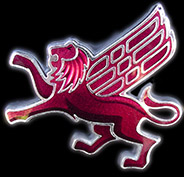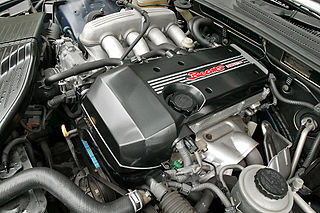See also
Automotive handling | |||||||
|---|---|---|---|---|---|---|---|
| Main topics | |||||||
| Spring types | |||||||
| Suspension types |
| ||||||
Chassis control system | |
|---|---|
Part of the Automobile series | |
| Suspension |
|
| Steering | |
| Brakes |
|
Toyota Active Control Suspension was (according to Toyota) the world's first fully active suspension. [1]
It was a complex hydropneumatic, computer-controlled active suspension system. This did away with conventional springs and anti-roll (stabiliser) bars in favour of hydraulic struts controlled by an array of sensors (such as yaw velocity sensors, vertical G sensors, height sensors, wheel speed sensors, longitudinal and lateral G sensors) that detected cornering, acceleration and braking forces. The system worked well and gave an unusually controlled yet smooth ride with no body roll. [2] However, the additional weight and power requirements of the system affected straight-line performance somewhat. [3] [4]
Introduced in September 1989 on the Japanese market only Toyota Celica ST183 GT-R Active Sports.
Ten years later, Mercedes-Benz introduced a very similar active suspension, called Active Body Control, on the Mercedes-Benz CL-Class in 1999.

The Toyota Celica is an automobile produced by Toyota from 1970 until 2006. The Celica name derives from the Latin word coelica meaning 'heavenly' or 'celestial'. In Japan, the Celica was exclusive to the Toyota Corolla Store dealer chain.

The Toyota Land Cruiser is a series of four-wheel drive vehicles produced by the Japanese automobile manufacturer Toyota. It is Toyota's longest running series of models. As of 2019, the sales of the Land Cruiser totalled more than 10 million units worldwide.

Electronic stability control (ESC), also referred to as electronic stability program (ESP) or dynamic stability control (DSC), is a computerized technology that improves a vehicle's stability by detecting and reducing loss of traction (skidding). When ESC detects loss of steering control, it automatically applies the brakes to help steer the vehicle where the driver intends to go. Braking is automatically applied to wheels individually, such as the outer front wheel to counter oversteer, or the inner rear wheel to counter understeer. Some ESC systems also reduce engine power until control is regained. ESC does not improve a vehicle's cornering performance; instead, it helps reduce the chance of the driver losing control of the vehicle.

The Toyota Supra is a sports car and grand tourer manufactured by the Toyota Motor Corporation beginning in 1978. The name "supra" is derived from the Latin prefix, meaning "above", "to surpass" or "go beyond".

Hydropneumatic suspension is a type of motor vehicle suspension system, designed by Paul Magès, invented by Citroën, and fitted to Citroën cars, as well as being used under licence by other car manufacturers, notably Rolls-Royce, Maserati and Peugeot. It was also used on Berliet trucks and has more recently been used on Mercedes-Benz cars, where it is known as Active Body Control. The Toyota Soarer UZZ32 "Limited" was fitted with a fully integrated four-wheel steering and a complex, computer-controlled hydraulic Toyota Active Control Suspension in 1991. Similar systems are also widely used on modern tanks and other large military vehicles. The suspension was referred to as oléopneumatique in early literature, pointing to oil and air as its main components.

The Toyota Soarer is a personal luxury GT coupé produced from 1981 to 2005 by Toyota and sold in Japan. It was available at both Japanese Toyota dealerships called Toyota Store and Toyopet Store, and it debuted with the Z10 series, replacing the Toyopet Store exclusive Mark II coupé, and the Toyota Store exclusive Crown coupé.

The Lexus LS is a full-size luxury sedan serving as the flagship model of Lexus, the luxury division of Toyota. For the first four generations, all LS models featured V8 engines and were predominantly rear-wheel-drive. In the fourth generation, Lexus offered all-wheel-drive, hybrid, and long-wheelbase variants. The fifth generation changed to using a V6 engine with no V8 option, and only one length was offered.

The Infiniti Q45 is a full-size, rear wheel drive, four-door, V8-powered luxury sedan manufactured and marketed by Nissan's Infiniti brand for model years 1989-2006, over three generations.

An anti-roll bar is a part of many automobile suspensions that helps reduce the body roll of a vehicle during fast cornering or over road irregularities. It connects opposite (left/right) wheels together through short lever arms linked by a torsion spring. A sway bar increases the suspension's roll stiffness—its resistance to roll in turns—independent of its spring rate in the vertical direction. The first stabilizer bar patent was awarded to Canadian inventor Stephen Coleman of Fredericton, New Brunswick on April 22, 1919.

Active Body Control, or ABC, is the Mercedes-Benz brand name used to describe electronically controlled hydropneumatic suspension.

The Mercedes-Benz W140 is a series of flagship vehicles manufactured by Mercedes-Benz from 1991 to 1998 in sedan/saloon and coupe body styles and two wheelbase lengths. Mercedes-Benz unveiled the W140 S-Class at Geneva Motor Show in March 1991 with sales launch in April 1991 and North American launch on 6 August 1991.

The Citroën Activa and Activa 2 were two concept cars produced by the French manufacturer Citroën as a means to test and to showcase features intended for future use in their production cars. Both were unveiled at the Paris Motor Show in 1988 and 1990 respectively. The name Activa was later used to refer to the production Xantia fitted with Activa suspension.
Air suspension is a type of vehicle suspension powered by an electric or engine-driven air pump or compressor. This compressor pumps the air into a flexible bellows, usually made from textile-reinforced rubber. Unlike hydropneumatic suspension, which offers many similar features, air suspension does not use pressurized liquid, but pressurized air. The air pressure inflates the bellows, and raises the chassis from the axle.

The Toyota S Series engines are a family of straight-4 petrol or CNG engines with displacement from 1.8 L to 2.2 L produced by Toyota Motor Corporation from January 1980 to August 2007. The series has cast iron engine blocks and alloy cylinder heads.
An active suspension is a type of automotive suspension on a vehicle. It uses an onboard system to control the vertical movement of the vehicle's wheels relative to the chassis or vehicle body rather than the passive suspension provided by large springs where the movement is determined entirely by the road surface. Active suspensions are divided into two classes: real active suspensions, and adaptive or semi-active suspensions. While semi-adaptive suspensions only vary shock absorber firmness to match changing road or dynamic conditions, active suspensions use some type of actuator to raise and lower the chassis independently at each wheel.

All-Trac was a proprietary full-time four-wheel drive system used on a variety of Toyota badged models from 1988 to 2000. It was considered a revolutionary advance for four wheel drive automobiles into the mainstream consumer market and its electronic/vacuum controlled locking center differential was rare in a passenger car. The system originated in Japan under the GT-Four name in 1986, but was not released in the U.S. until 1988 under the All-Trac name.

The Mercedes-Benz C112 was an experimental mid-engine concept car built in 1991 by German automobile manufacturer Mercedes-Benz as a test bed, similar to the later versions of the C111. Despite using the same chassis code, it was not related to the W112 series of limousines and coupes of the 1960s. The C112 was intended to be the road-legal counterpart of the Sauber-built C11 Group C prototype race car developed for the 1990 World Sports-Prototype Championship.

Active Power Stabilizer Suspension System (APSSS), is an electric active suspension system with active anti-roll bars developed by Toyota Motor Corporation for its high-end vehicles including Lexus models. By altering stabilizer bar stiffness, this system acts to reduce body tilt during cornering, keeping the vehicle more level during turns and improving handling, as opposed to the natural tendency of a vehicle to roll due to the lateral forces experienced during high-speed maneuvering. The active stabilizer system relies on vehicle body sensors and electric motors. The first production usage of this system was introduced in August 2005 with the Lexus GS430 sport sedan, followed by the 2008 Lexus LS 600h luxury sedan. The development of APSSS is claimed to be the world's first electric active stabilizer system. It is a system improvement of an earlier Toyota technology called Toyota TEMS.
TEMS is a shock absorber that is electronically controlled based on multiple factors, and was built and exclusively used by Toyota for selected products during the 1980s and 1990s. The semi-active suspension system was widely used on luxury and top sport trim packages on most of Toyota’s products sold internationally. Its popularity fell after the “bubble economy” as it was seen as an unnecessary expense to purchase and maintain, and remained in use on luxury or high performance sports cars.
{{cite journal}}: Cite journal requires |journal= (help)